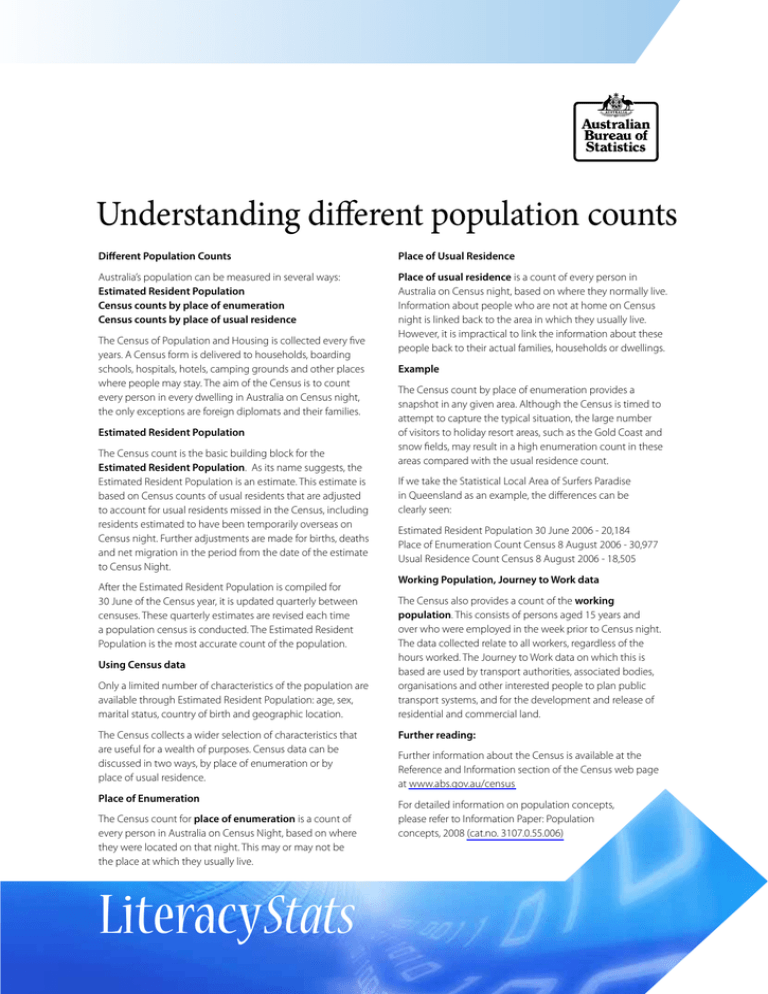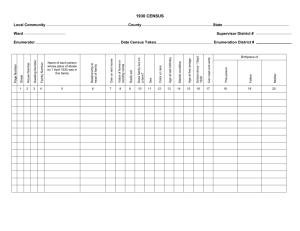Understanding different population counts
advertisement

Understanding different population counts Different Population Counts Place of Usual Residence Australia’s population can be measured in several ways: Estimated Resident Population Census counts by place of enumeration Census counts by place of usual residence Place of usual residence is a count of every person in Australia on Census night, based on where they normally live. Information about people who are not at home on Census night is linked back to the area in which they usually live. However, it is impractical to link the information about these people back to their actual families, households or dwellings. The Census of Population and Housing is collected every five years. A Census form is delivered to households, boarding schools, hospitals, hotels, camping grounds and other places where people may stay. The aim of the Census is to count every person in every dwelling in Australia on Census night, the only exceptions are foreign diplomats and their families. Estimated Resident Population The Census count is the basic building block for the Estimated Resident Population. As its name suggests, the Estimated Resident Population is an estimate. This estimate is based on Census counts of usual residents that are adjusted to account for usual residents missed in the Census, including residents estimated to have been temporarily overseas on Census night. Further adjustments are made for births, deaths and net migration in the period from the date of the estimate to Census Night. After the Estimated Resident Population is compiled for 30 June of the Census year, it is updated quarterly between censuses. These quarterly estimates are revised each time a population census is conducted. The Estimated Resident Population is the most accurate count of the population. Using Census data Only a limited number of characteristics of the population are available through Estimated Resident Population: age, sex, marital status, country of birth and geographic location. The Census collects a wider selection of characteristics that are useful for a wealth of purposes. Census data can be discussed in two ways, by place of enumeration or by place of usual residence. Place of Enumeration The Census count for place of enumeration is a count of every person in Australia on Census Night, based on where they were located on that night. This may or may not be the place at which they usually live. LiteracyStats Example The Census count by place of enumeration provides a snapshot in any given area. Although the Census is timed to attempt to capture the typical situation, the large number of visitors to holiday resort areas, such as the Gold Coast and snow fields, may result in a high enumeration count in these areas compared with the usual residence count. If we take the Statistical Local Area of Surfers Paradise in Queensland as an example, the differences can be clearly seen: Estimated Resident Population 30 June 2006 - 20,184 Place of Enumeration Count Census 8 August 2006 - 30,977 Usual Residence Count Census 8 August 2006 - 18,505 Working Population, Journey to Work data The Census also provides a count of the working population. This consists of persons aged 15 years and over who were employed in the week prior to Census night. The data collected relate to all workers, regardless of the hours worked. The Journey to Work data on which this is based are used by transport authorities, associated bodies, organisations and other interested people to plan public transport systems, and for the development and release of residential and commercial land. Further reading: Further information about the Census is available at the Reference and Information section of the Census web page at www.abs.gov.au/census For detailed information on population concepts, please refer to Information Paper: Population concepts, 2008 (cat.no. 3107.0.55.006)





